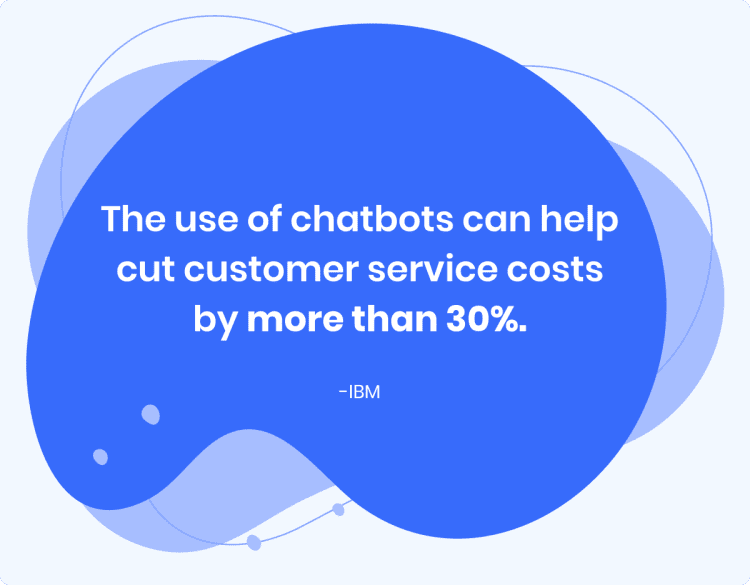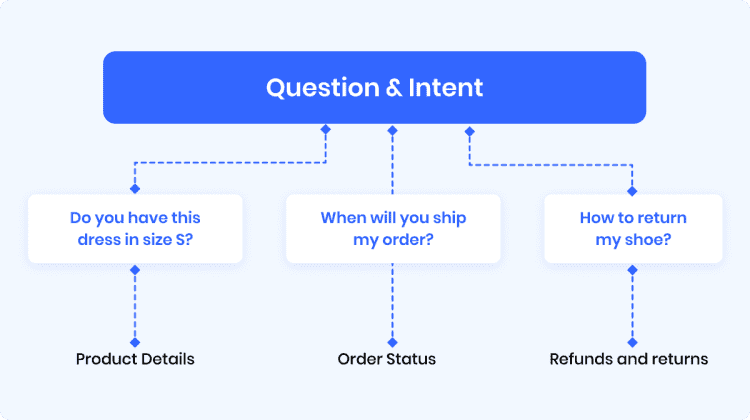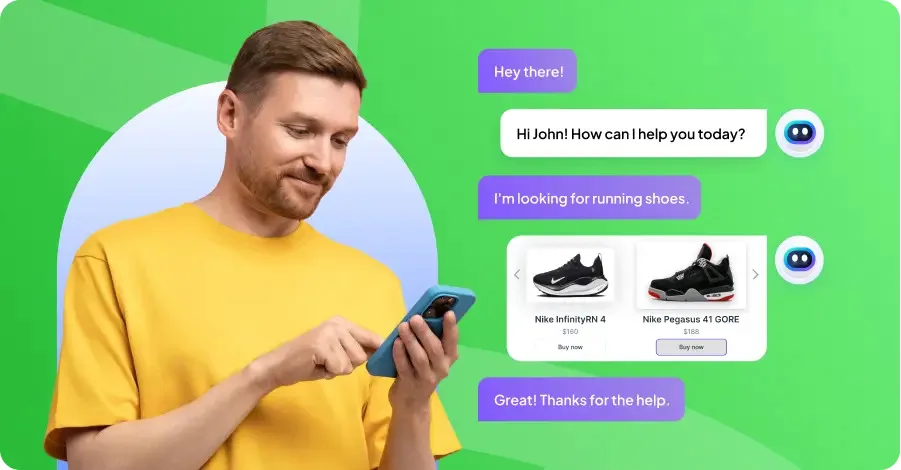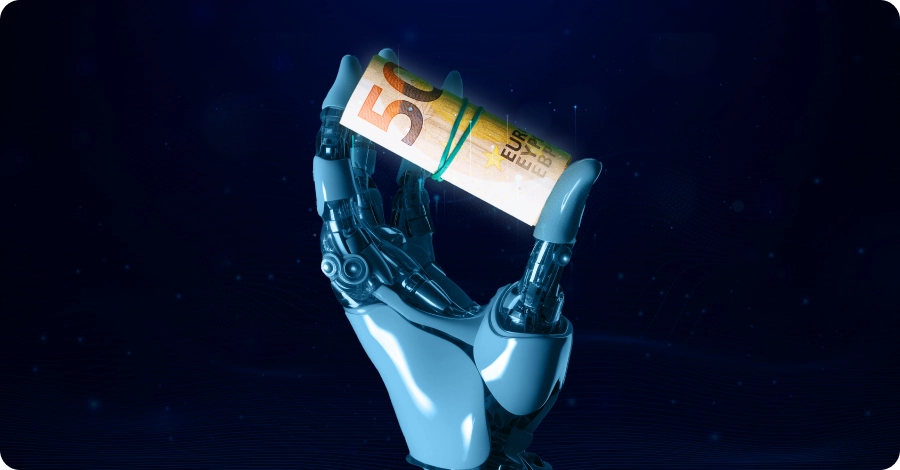Chatbot Training- How to Train Your Chatbot?
- April 17, 2023
- 12 mins read
- Listen

Table of Content
You want to engage with your online customers and integrate a chatbot on your website and mobile app. Great choice! You know what a chatbot is and how it can benefit your business. Perfect! But what about chatbot training so that it can interact efficiently with your customers? Now here the situation becomes a bit tricky. Actually, having a chatbot is just like having a pet at home. You need to train it. It will be a complete mess if you don’t know how to do it.
From where to start? Well, your answer is right here. Here in this blog, I will discuss how you can train your chatbot and engage with more and more customers on your website.
Chatbot Training: Key Terms You Need to Know
Related to chatbots, there are different terms we hear many times. But it’s fine not to know them all. Let’s concentrate on the essential terms specifically related to chatbot training.
It would be helpful if you know the below-mentioned terms such as:
-
Intent
In the context of chatbot training, an “intent” refers to the goal or objective behind a user’s message or query. It is a specific purpose or intention that the user is trying to achieve through their interaction with the chatbot.
-
Utterances
It refers to the messages or statements that users input or say to a chatbot. Utterances can take many forms, such as text messages, voice commands, or button clicks. Chatbots are trained using a dataset of example utterances, which helps them learn to recognize different variations of user input and map them to specific intents.
-
Entity
An entity is a specific piece of information that the chatbot needs to identify and extract from the user’s input.
-
Trigger
A trigger is a keyword or phrase that the chatbot is programmed to recognize as a signal to initiate a particular response or action.
-
Action
It is a specific response or set of responses that the chatbot is programmed to take based on the user’s input and the context of the conversation.
What is Chatbot Training?
Chatbot training involves using machine learning algorithms to enable a chatbot to understand and generate human-like responses by analyzing and processing large amounts of conversational text data. The training process involves providing the chatbot with relevant input and output examples to help it learn and improve over time.
Well-trained chatbots can understand human emotions, interpret the underlying intentions behind human conversations, and accurately predict what users want. As chatbots receive more training and maintenance, they become increasingly sophisticated and better equipped to provide high-quality conversational experiences.
A chatbot that can provide natural-sounding responses is able to enhance the user’s experience, resulting in a seamless and effortless journey for the user.
Why Should You Train Your Chatbot?
Yes, training your chatbot is important. Regular training enables the bot to understand and respond to user requests and inquiries accurately and effectively. Without proper training, the chatbot may struggle to provide relevant and useful responses, leading to user frustration and dissatisfaction.
Now, let’s go through the main reasons!
-
Better Customer Experience
Regular training allows the chatbot to personalize interactions and deliver tailored responses at various stages of the customer journey. It can also be a helpful resource for first-time visitors, as it provides information about products and services they are searching for without having to search for the information throughout the website. This can enhance the customer experience and contribute to a seamless journey for potential customers.
By training the chatbot to understand user intent and context, you can ensure that customers receive prompt and relevant support at all times, leading to higher customer satisfaction rates and improved brand reputation.
-
Cost-Effective
There are general FAQs that customers ask on a frequent basis. Chatbots are there to help them with such queries. By training the chatbot, its level of sophistication increases, enabling it to effectively address repetitive and common concerns and queries without requiring human intervention.
This eliminates the need for you to hire additional staff for such tasks, resulting in significant cost savings. Moreover, your existing employees can devote more time to strategic decision-making activities.
-
Multilingual Customer Support
With chatbot training, now you can engage with your customers and offer assistance in multiple languages. It helps you to reach out to a diverse customer base and provide them with support in their preferred language, regardless of their location.
Whenever a customer lands on your website, the chatbot automatically selects the appropriate language of that region he is in. This capability enhances customer satisfaction by creating a personalized experience and establishing stronger connections with the customer base.
-
Better Accuracy
Yes, chatbots do make mistakes and sometimes may not be able to provide accurate responses to your customer queries. This is the reason why training your chatbot is so important to enhance its capabilities of understanding customer inputs in a better way.
Continuous training ensures that chatbots do not repeat their mistakes while training them with pertinent information enhances their intelligence and accuracy. Ultimately, accurate chatbots are more reliable and valuable tools for companies to interact with their customers.
What Happens If You Don’t Train Your Chatbot?
If an AI chatbot is not trained properly, it may fail to provide accurate and relevant responses to user queries, leading to a poor user experience. Let’s look into some of the potential consequences:
- Inaccurate Responses: Without proper training, the chatbot may not be able to understand the nuances of language and context, leading to inaccurate or irrelevant responses to your customer queries.
- Poor Customer Experience: Customers may become frustrated with the chatbot’s inability to provide useful responses, resulting in a poor user experience and potentially driving them away from your business.
- Damage to Brand Reputation: A poorly functioning chatbot can damage your company reputation, especially if customers share negative experiences on social media or review sites.
- Reduced Efficiency: An untrained chatbot may not be able to handle high volumes of user queries, leading to delays and reduced efficiency in customer service operations.
- Missed Opportunities: The chatbot may miss opportunities to upsell or cross-sell products, provide personalized recommendations, or offer other value-added services to customers.
So, failing to train your AI chatbot can lead to a range of negative consequences. Proper training is essential to ensure that the chatbot can effectively serve its intended purpose and provide value to your customers.
How to Train Your Chatbot?
Now that we have understood the benefits of chatbot training and its related terms, let’s discuss how you can train your AI bot. It’s all about understanding what your customers will ask and expect from your chatbot. Also, I hope you have defined all the use cases for the chatbot.
Training a chatbot involves teaching it to understand natural language and respond appropriately. The more data and feedback a chatbot receives, the more it can improve its accuracy and effectiveness. In this process, identifying the purpose and goals of the chatbot, collecting relevant data, pre-processing the data, and using machine learning techniques are important steps.
Now, let’s explore these steps in more detail to help you train your chatbot and ensure it is providing accurate and valuable interactions with your customers.
-
Understand the Use Cases
When training an AI-enabled chatbot, it’s crucial to start by identifying the particular issues you want the bot to address. While it’s common to begin the process with a list of desirable features, it’s better to focus on a specific business problem that the chatbot will be designed to solve. This approach ensures that the chatbot is built to effectively benefit the business.
Starting with the specific problem you want to address can prevent situations where you build a chatbot for a low-impact issue. For instance, if you aim to create a chatbot to enable customers to track their order status but later discover that this accounts for less than 3% of your overall query volume, you may want to consider a different use case. By focusing on the problem, you want to solve, you can avoid such situations and ensure that your chatbot provides value to your customers and business.
-
Develop Specific Intents
Your AI chatbot should interpret customer inputs and provide appropriate answers based on their queries. If it fails, it will be frustrating for both you and your customers. To avoid such mishaps, develop specific intent that serves one predefined purpose.
Suppose you want to help customers in placing an order through your chatbot. In that case, you can create a corresponding intent called #buy_something, which is indicated by the preceding “#” symbol before the intent name. This naming convention helps to clearly distinguish the intent from other elements in the chatbot.
-
Each Intent Should Contain Various Utterances
The effectiveness of your AI chatbot is directly proportional to how accurately the sample utterances capture real-world language usage. While creating and testing the chatbot, it’s crucial to incorporate a wide range of expressions to trigger each intent, thereby improving the bot’s usability.
To Achieve accuracy, you will require multiple iterations. It’s essential to update the custom values and sample utterances continually to ensure that all possible phrasings are covered.
Continuing with the previous example, suppose the intent is #buy_something. In that case, you can add various utterances such as “I would like to make a purchase” or “Can I buy this now?” to ensure that the chatbot can recognize and appropriately respond to different phrasings of the same intent.
-
Develop a Diverse Team
Developing a diverse team to handle bot training is important to ensure that your chatbot is well-trained. A diverse team can bring different perspectives and experiences, which can help identify potential biases and ensure that the chatbot is inclusive and user-friendly.
Involve team members from different departments such as customer service, marketing, and IT, to provide a well-rounded approach to chatbot training. Ensure that team members understand the importance of diversity and inclusivity and how to recognize potential biases in the training data. By developing a diverse team for chatbot training, you can offer a better user experience and increased customer satisfaction.
-
Your Entities Should be Relevant
After composing multiple utterances, identify the significant pieces of information by marking the corresponding words or phrases. These will serve as the entities that capture essential data, eliminating the need to label every term in an utterance.
It is recommended to avoid using single-word statements such as “Barcelona” as entities since they may create confusion for your chatbot. The purpose of entities is to extract pertinent information accurately.
-
Give your Chatbot a Personality
Choosing the appropriate tone of voice and personality for your AI-enabled chatbot is important in creating an engaging and effective customer experience. Your brand may typically use a professional tone of voice in all your communications, but you can still create a chatbot that is enjoyable and interactive, providing a unique experience for customers.
Creating a chatbot with a distinctive personality that reflects the brand’s values and connects with customers can enhance the customer experience and brand loyalty.
-
Add Media Elements
Adding media elements to your chatbot can enhance the user experience and make interactions more engaging. To incorporate media into your chatbot, first, determine the type of media that aligns with your chatbot’s purpose. For example, if your chatbot provides educational content, video tutorials may be beneficial.
Next, consider the media’s placement in the chatbot’s responses. You can include images, videos, or audio clips as part of the chatbot’s responses, or provide links to external content. Additionally, ensure that the media elements are optimized for the platform and device your chatbot will be used on to avoid any technical difficulties.
Adding media to your chatbot can provide a dynamic and interactive experience for users, making the chatbot a more valuable tool for your brand.
-
Update Your Chatbot on a Regular Basis
Deploying your chatbot is only one part of the process. Continuous improvement is necessary for a successful chatbot. Identifying areas where your AI-powered chatbot requires further training can provide valuable insights into your business and the chatbot’s performance.
It is essential to recognize the new intents, or user requests to improve and gain knowledge about training a chatbot. You may be surprised to know how customers interact with your chatbot, and based on that you can update and optimize the overall process. Remember that refining your chatbot over time can improve its effectiveness and enhance the user experience.
Key Takeaway!
Training is an important process that helps to improve the effectiveness and accuracy of chatbots in various applications. By understanding the basics of natural language processing, data preparation, and model training, developers can create chatbots that are better equipped to understand and respond to user queries. It is important to continuously monitor and evaluate chatbots during and after training to ensure that they are performing as expected.
Overall, chatbot training is an ongoing process that requires continuous learning and improvement. With the right techniques and strategies, developers can create chatbots that are more intelligent, intuitive, and effective in meeting the needs of users.
What are your thoughts? Share with us in the comment section below.






